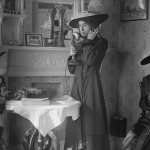The shake-up applied to the change of season
Believe it or not, even a transition into fall could be the perfect opportunity to work on expanding our comfort zones. I came to this conclusion after a unique journey that involves the New Yorker, Marie Kondo, and the recent climate change challenge. Guess what they have in common? An invisible red thread: the idea that a mindful closet switchover could be an opportunity to expand our comfort zones.
Fil rouge, filo rosso, and red thread
Have you eve experienced a sort of detachment from the life around you? Have you ever found yourself in a situation but also an external observer of the same circumstance? Have you ever experienced a sort of slow-motion view of different places, people, objects, topics, and news with or without you in it? All you can see is a link that connects everything, even things that don’t (apparently) have anything in common. This happened to me recently when I found a red thread
I like to look for what in Italy we call fil rouge or filo rosso in my life and in the world around me. The best way to express the same concept in English is the red thread. The red thread of fate is an Eastern Asian belief originating from Chinese legend.
“According to this myth, the gods tie an invisible red cord around the finger of those that are destined to meet one another in a certain situation as they are their true love. The two people connected by the red thread are destined lovers, regardless of place, time, or circumstances.”—Wikipedia
Think of the concept of the red thread applied to your life and the environment in which you live. Try to look for your red thread, connecting things without evident correlations. It’s also a great exercise for something we all value: expressing our creativity.
Back to our story—The New Yorker, Marie Kondo, and the climate change challenge: what do they have in common? The title of the article partially gives away the answer, but allow me to bring you on this journey. Allow me to describe the red thread I found supporting the key message of the article: a mindful closet switchover could be an opportunity to expand our comfort zones.
The New Yorker
I am finally a proud subscriber of The New Yorker—the American weekly magazine focused on the cultural life of New York City. The first copy ever delivered in my mailbox was the October 21, 2019 issue, where I found the article After a fashion. TheRealReal brings high-end goods into the “circular economy” by Susan Orlean. Our imaginary red thread starts here.
The expression circular economy may provide you with an idea of where I am going with this, but please bear with me. The main article’s focus is on the e-commerce platform called TheRealReal, which sells previously owned luxury goods. While the idea of selling used clothes is not new, entrepreneur Julie Wainwright—who founded the platform in 2011—was able to find the company’s white space in going global and high end.
I don’t know how much you know about the clothing-resale business. The article made me hungry to know more, especially after the following data points.
“According to a report by the consignment company ThredUp, which used research from GlobalData, a retail-analytics firm, resale was a twenty-four-billion-dollar market in 2018, and will grow to sixty-four billion dollars by 2028, making it one and a half times the size of the behemoth fast-fashion business—the Zaras and H&Ms and Forever 21s of the world.”
That’s a big market. It’s a market that is expected to grow. Also:
“Some people might think buying used clothing is icky, but nine million more people bought secondhand clothes in 2017 than in 2016, and, according to “Rise of the Fashion Resale Marketplace,” a report released earlier this year by the investment bank Raymond James, sixty-two percent of women say that they have bought or are willing to buy secondhand.”
Why shoppers buying secondhand?
Among other motivations, “thirty percent said that buying resale is an environmentally responsible choice. Fashion is one of the world’s most polluting industries. Extending the life of an article of clothing or a pair of shoes, making it part of the ‘circular economy,’ keeps it out of the trash.”
The article made me think about my behaviors when it comes to “closet management.” Have you ever thought about the impact of your clothing (and shoe) choices? It’s incredible to realize how important our everyday decisions are in this area.
I’ve started a personal shake-up a few months back. I found myself approaching shopping in a different—and much more conscious—way. I am just at the beginning of this transformation process, and I am still learning, but what I can already say is that it begins with a shift in mindset.
I grow up with the idea of having a huge closet and an even bigger shoe closet with options—A LOT of options. I remember my weekends in Milan between Via Torino and Corso Vittorio Emanuele (one of the shopping areas in Milan), which were often centered on shopping.
My region, Le Marche, is well known for shoe production (it is where most of the Italian shoe manufactures produce their shoes), another must-do for shopping.
When I moved to New York, I discovered the convenience of the department stores first and then attractiveness of the famous New York Sample Sales!
Long story short, I ended up being submerged in an enormous amount of shoes and clothes in a tiny city apartment.
Thank God we moved every couple of years, and I acquired a certain level of confidence with the The Life-Changing Magic of Tidying Up by Japanese organizing consultant and author Marie Kondo.
Marie Kondo
Our imaginary red thread continues here with Marie Kondo.
Listed as one of Time‘s 100 most influential people in 2015, Marie Kondo has written four books on organizing, which have collectively sold millions of copies and have been translated from Japanese into several languages. In the United States and the UK, the Netflix series Tidying Up with Marie Kondo, released in 2019, has been a great success.
It’s about choosing joy is the KonMari mantra—as you can see from her website.
The KonMari Method™ encourages tidying by category—not by location—beginning with clothes, then moving on to books, papers, komono (miscellaneous items), and, finally, sentimental items. Keep only those things that speak to the heart, and discard items that no longer spark joy. Thank them for their service, then let them go.
Kondo starts with clothes as a category. Two key components of her method inspired my journey.
1) The filter
2) The lasting effect
The filter is about tidying up by selecting and keeping, among all your clothes, what sparks joy. Tidying up with the right method avoids rebound and leads to a shift in mindset: the lasting effect.
The climate change challenge
Here we are. Our imaginary red thread brings us back to the climate change challenge #ShakeUppersActNow. Among the ten climate actions recommended by the UN, there is one called the Zero-Waste fashion initiative.
The fashion industry is the second-highest user of water worldwide. Ten thousand liters of water are needed to produce one pair of jeans, equivalent to how much water a person drinks in 10 years. By creating new clothes out of old ones, you help to save water and reduce waste.
What is the biggest challenge for TheRealReal?
“Passivity! Having things in your closet just sitting there, rather than clearing them out and consigning!” according to The New Yorker article.
I understood that it is all about comfort: being comfortable settling down and living in a cluttered situation instead of tidying up and keeping what sparks joy in our lives; being comfortable and unconscious of the real impact of day-to-day decisions when it a matter of climate change.
A shake-up is what I am looking for. A shake-up that sees a mindful closet switchover as an opportunity to expand our comfort zones.
Do you see the red thread?
Photo by Canva





